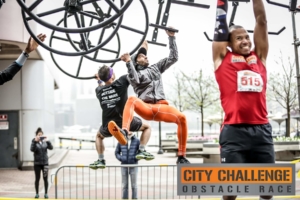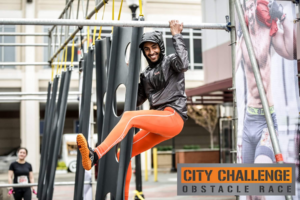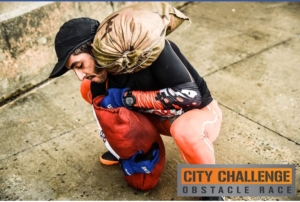Race Recap: City Challenge
Author: Jorge Estevez
Go to Source
City Challenge Race is an urban obstacle course race with 20+ unique obstacles that test your agility, strength, and technique. This race is fun and can be a good start for beginners who want to do their first OCR or want to use it for overall fitness training. Are obstacles hard? Depends on your level of fitness. This is not your typical mud run, there is actually no mud whatsoever at any City Challenge race. Their motto is “Think outside of the mud”, which is very clever for an OCR, yet cool and unique.
The first of five races for the year of 2019 took place in Jersey City, NJ on April 20th. This is a unique venue because it is located adjacent to the Hudson River and allows for a beautiful view of NYC’s landscape across the river.
I have done a couple of City Challenge races in the past, but this was my first time at this location (Jersey City). I really liked the set-up of the course, even though it was not laid out as per the course map posted on their socials. This is something that every race does, and it can be frustrating for some of us who like to study the course ahead of time to not be surprised on race day, but unfortunately things happen and sometimes the building crew have to adjust or re-arrange an obstacle, or completely change/remove it due to restraints or last-minute complications, and that’s understandable.
OBSTACLES & SAFETY
Some of the feature obstacles that you can expect to see at almost every single City Challenge race are Police Barricades, Kettlebell Swings (30), Heavy Jump ropes (30), Cinder Block Carry (2 blocks), CKO Kickboxing Bags, Rope Climb, a few walls, a rig, and the famous Car Jump (NYC taxi and police cars). This year we saw two new obstacles: Tricky Swiss and Urban Cliffhanger. Both fun but also very challenging. Urban Cliffhanger had the highest failure rate of the day because it requires a lot of grip and core strength as well as balance, coordination, and technique. The weather conditions made this obstacle ten times harder to complete.
The lack of multi-lanes at certain obstacles caused a lot of bottlenecking for the elites. This is an issue that has happened in the past and it hasn’t been corrected yet. The main obstacle that caused lots of bottlenecking was “Urban Balance Beam,” which is a 24-foot-long obstacle were athletes have to balance through an inclined piece of wood followed by a couple of unstable tires. This obstacle typically gives athletes a hard time, but this one specifically had to be shut down a few minutes after the elite males went off because almost nobody was able to get across the obstacle.
The Race director said that they closed it because it became unsafe due to the weather conditions, but it got less safe because the structure was not screwed down to the ground. This made the structure unstable and shaky, thus making it almost impossible for athletes to get across it. I somehow managed to get across quickly, but many people stayed behind due to that one obstacle. Some guys I personally know are faster than me, and some that have even been on the podium before, lost plenty of time at that obstacle and at the end of the day it got closed down and a “30 burpee” last-minute call was applied instead. This is unfair, to an extent, for certain athletes who are competing for a podium spot because this race was timed, but we also have to understand that these kinds of things happen and we cannot just complain about it and/or say bad things about the race and/or the race director just because your time was off by a few minutes.
Another obstacle that took a lot of re-tries was Skyscraper, which is similar to the Z-wall from Spartan race, but straightened out without the zig-zag shape. Lastly, Urban Cliffhanger, as I said before, was the nemesis for most people due to its complexity but also because the attachments were wet and slippery from the rain. Yet again, I noticed that the structure for this obstacle was also not screwed down to the ground, which made it very unsafe after 3-4 people started to hang from the obstacle at the same time. The combined weight and movement from people swinging made the whole structure rock back and forth and you could see the base poles lift off the ground! Things got scary at some points and my friend was advising people to be careful as they approached the obstacle, luckily the structure remained intact.
ELITE & OPEN WAVES
The competitive wave had around 80+ participants, while the open waves had a few hundred combined. The elite wave (males) went off at 8:30 am-ish (delayed due to weather), and women went off about 15-20 minutes after. Followed by the open waves release every 5-10 minutes until 12:00 pm when the last wave went off. Fastest time of the day was 22 minutes and change for the men and 32 minutes and change for the women. The course was about 2.5 miles with 20+ obstacles.
There was an issue with the timing, which led to confusion on who the podium winners were. The race announced who the top 3 men and women were, and the award ceremony took place. Later on, it was announced that the timing was wrong and people got thrown off the podium and moved down several spots, while others like me, moved up a few spots. I ended up getting a top 10 finish spot, but I am not sure what the exact number is, neither are the “unknown” top 3 winners for each category. Top 5 from each gender also qualified for NorAms (North American Championships).
This race follows a Mandatory Obstacle Completion format. Elites are given a wrist band and must complete every obstacle before moving on to the next one.
“If one fails to successfully complete an obstacle, his/her band shall be removed”.
However, there were not enough volunteers to reinforce the rules and a lot of dishonest people who did not give up their band after failing an obstacle. Race organizers and/or the people in charge of the timing system did not make sure to check for elite wristbands at the finish line to see who actually kept their band and who didn’t, which immediately throws off the whole “mandatory obstacle completion” scheme. This is a shame because this race has a lot of potential to be one of the top OCRs out there, yet it has its flaws that can definitely be corrected but apparently not much care is given to it.
FINAL THOUGHTS
I personally like City Challenge Race a lot, from the venues to the obstacles to the festival area and the vendors. However, I was very disappointed to see all these flaws, knowing that registration costs nearly $100 and that I traveled to another state to have such a discouraging experience. Most of my friends felt the same way and I know a lot of other people did as well. I still see a lot of room for improvement for this race and it has a lot of potential to become one of the big names in the world of obstacle course racing. Hopefully, people’s feedback can help improve this and many other races to hopefully grow our sport to the point where we want it to get.
The remaining four City Challenge Races in 2019 are in Lowell, MA (May 4th); Stamford, CT (July 28th); Bronx, NY (August 17th); and Hoboken, NJ (October 5th). This year, there is a special deal going on where you can race any 3 of the 5 races for $159 or you can get a season pass and run all 5 races for $279. Running at least 3 races (no matter which) will award you the prestigious Tri-City Medal!
PS: Shoutout to the face of “Medal Addict” and MC of all City Challenge races, Justin Manning. Without your energy and enthusiasm, these races wouldn’t be the same. We love you Justin!
The post Race Recap: City Challenge appeared first on Mud Run, OCR, Obstacle Course Race & Ninja Warrior Guide.






